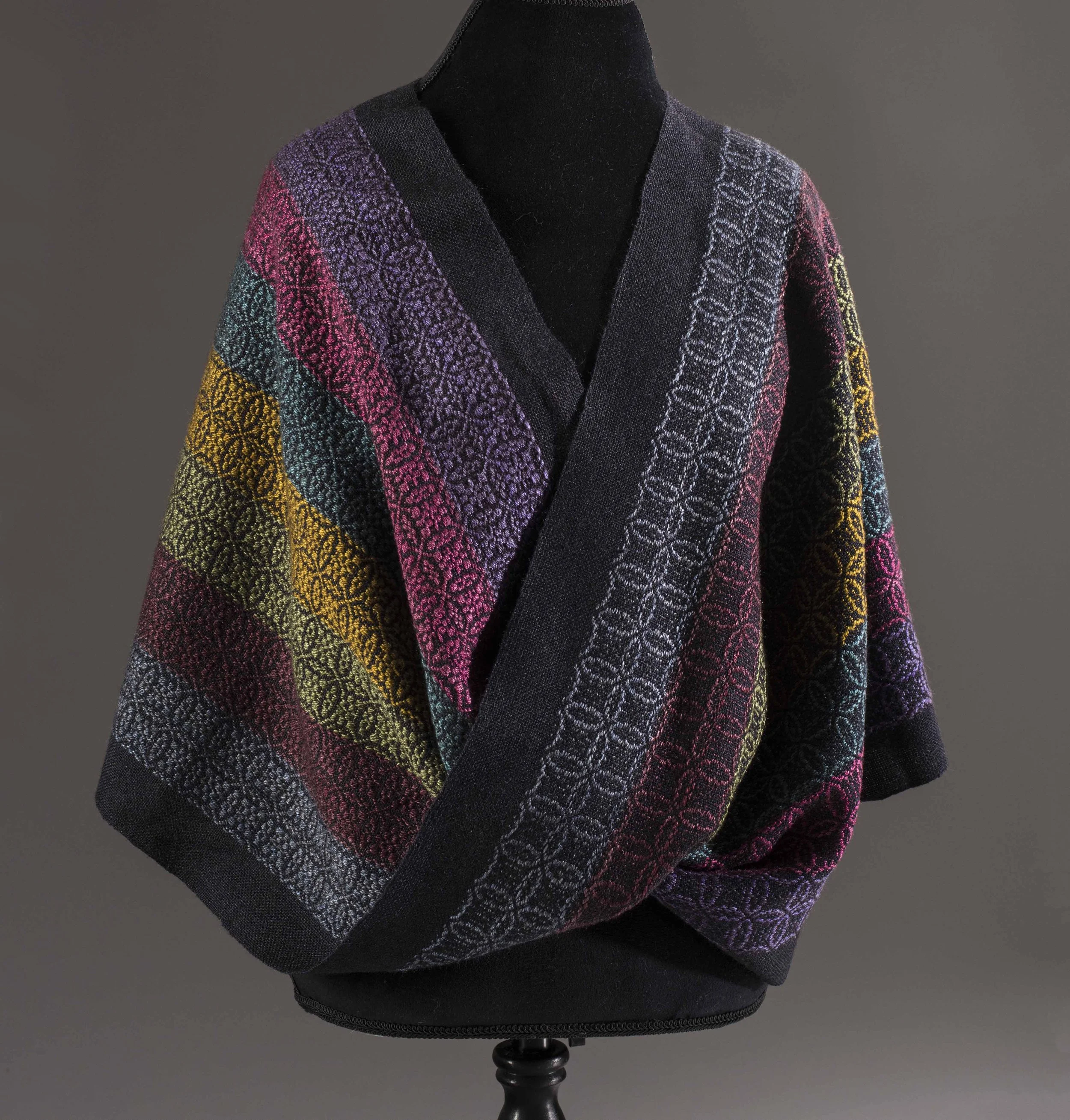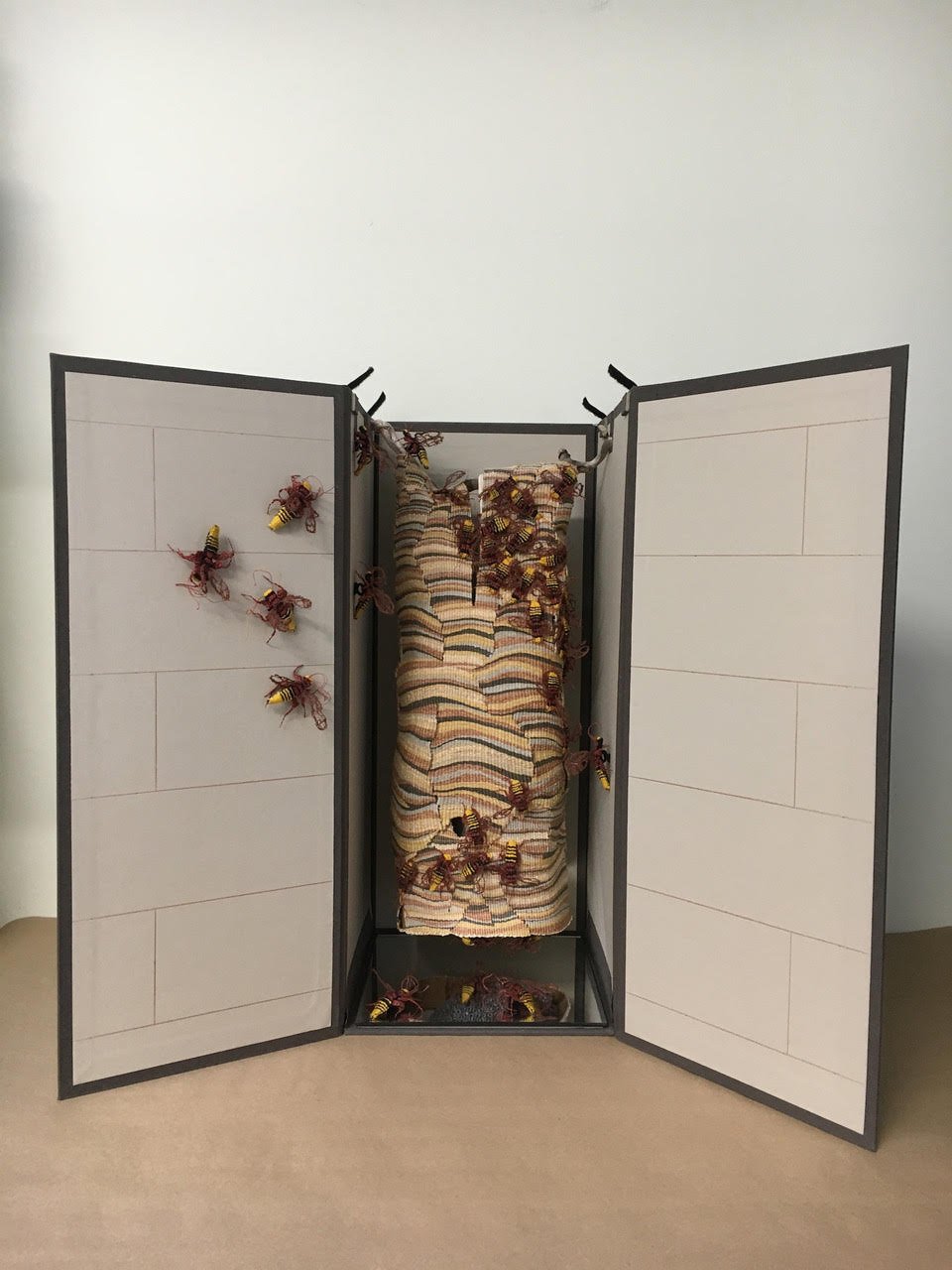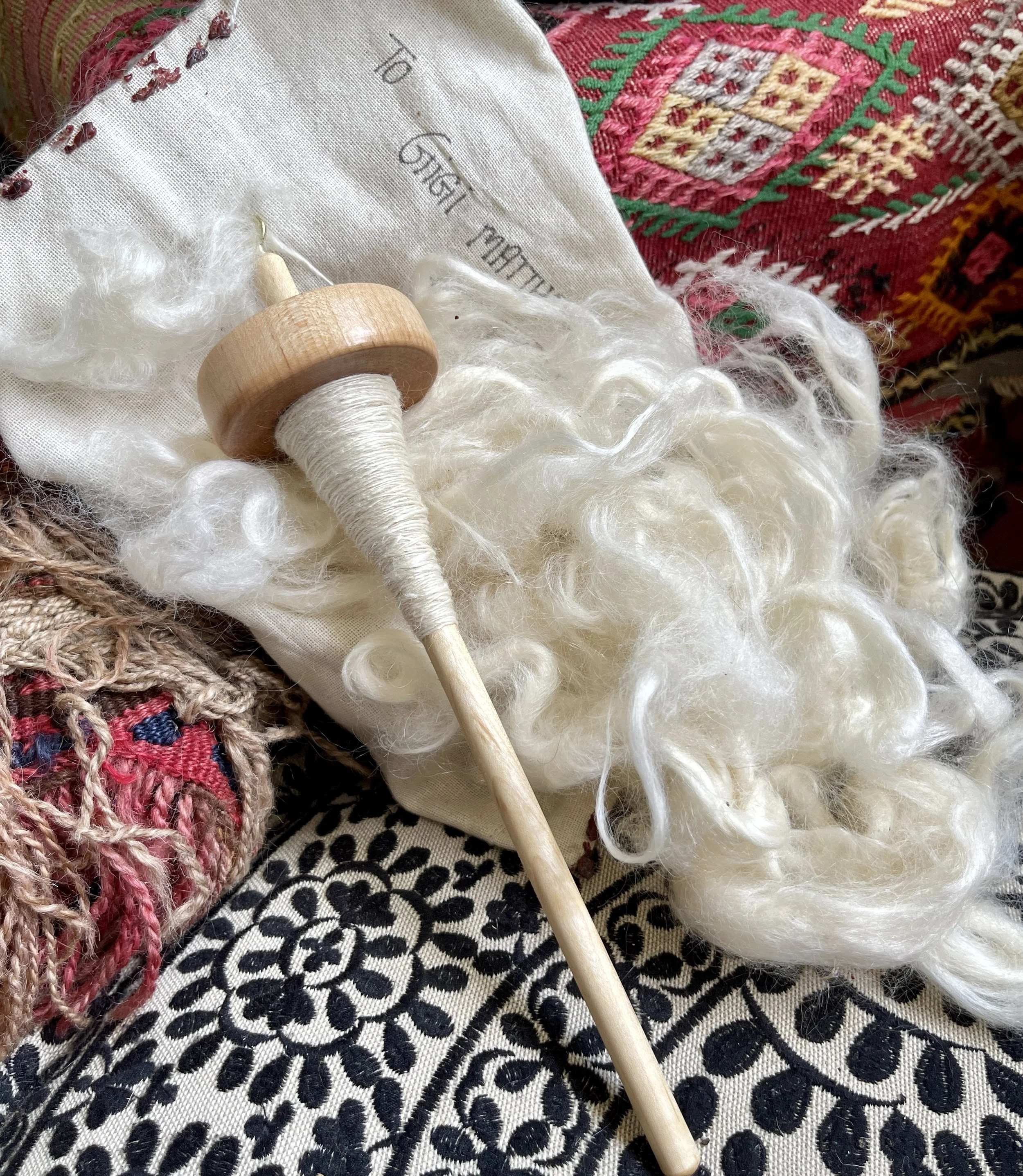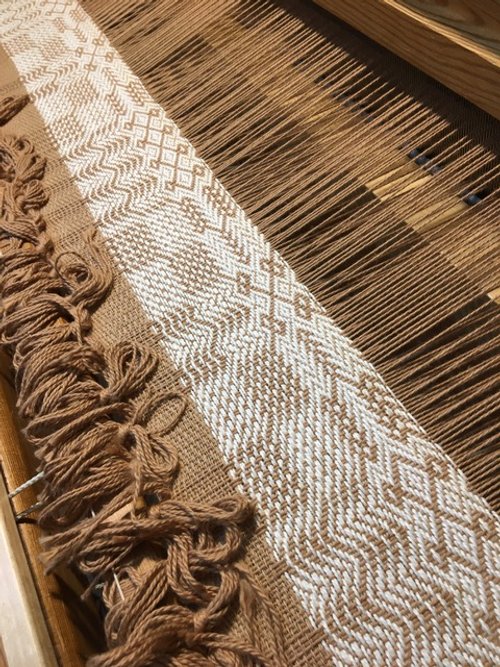
Weaving Wizard
Ask your weaving questions to our panel. Members, see more information under our Members page.

Make and Take – Korean Bojagi Mob Presenter: Anne Choi
We’ll learn about the history of bojagi, and see examples of how the tradition continues even in modern day. Using the traditional art of jogakbo, we’ll sew our own bojagi mobiles with silk organza fabric.

Weaving Wizard
Ask your weaving questions to our panel. Members, see more information under our Members page.

Introduction to Supplemental Warps Zoom Meeting
Presenter: Deb Essen
What are supplemental warps and how do they work? A quick tour/introduction to the weave structures woven with supplemental warps.
Deb Essen is the author of “Easy Weaving with Supplemental Warps”. Deb completed HGA’s Certificate of Excellence, Level 1 (2004) and is an inducted member of the Montana Circle of American Masters in Folk and Traditional Arts (2011). Her passion is teaching the wonders of weaving.

Weaving with Supplemental Warps Workshop Presenter: Deb Essen 2 Day Zoom Workshop
An introduction to the weave structures woven with supplemental warps without a second back beam! Advanced Beginner through Advanced Experience. Students must be comfortable warping their looms.

Learn to Weave – In person class Presenter: Anne Choi
Designed for beginners, this workshop promises to demystify the art of multi-shaft weaving. We will explore the full process of turning yarn into fabric from planning a project, winding a warp, warping the loom, reading a draft, and weaving good cloth. We will learn on vintage 4-shaft Structo looms, which are complete table looms, in miniature. By the end of the workshop, each new weaver will have their own sampler of structures including various twills, rib, and basket weave to take home.

Weaving Wizard
Ask your weaving questions to our panel. Members, see more information under our Members page.

Tapestry and Art Zoom Meeting
Presenter: Susan Martin Maffei
Susan will discuss her most current work which is multi-dimensional in both construction of an object using tapestry as the core in addition to book arts, found objects, crochet and works on paper. Examples of her style and use of warping and warp manipulation will be covered as well.

Weaving Wizard
Ask your weaving questions to our panel. Members, see more information under our Members page.

AI and Weaving Presenter: Alanna Wilcox Zoom Meeting
Fiber artist and educator Alanna Wilcox shares how she uses photographs of her own woven textiles as the starting point for digital creations using artificial intelligence. Designed for weavers who may have little to no experience with AI, this talk offers a clear, accessible look at what these tools can do and how they relate to the creative process.

Weaving Wizard
Ask your weaving questions to our panel. Members, see more information under our Members page.

How to Read a Swatch Presenter: Patrice George (Note: Second Wednesday of April)
Learn reverse analysis or how to read design information directly from any woven fabric sample.

Swedish Rosepath Rugs 2 Day Workshop
Presenter – Nancy Crampton
Explore Swedish rosepath threading to use for rugs, table runners and placemats. Learn rug-warping techniques, along with weft fabric calculation and preparation, and become comfortable with rag rug-weaving fundamentals.

Weaving Wizard
Ask your weaving questions to our panel. Members, see more information under our Members page.

Weaving Wizard
Ask your weaving questions to our panel. Members, see more information under our Members page.

Swatch Exchange – Supplemental Warps
Members share their projects based on the theme “Supplemental Warps”

Weaving Wizard
Ask your weaving questions to our panel. Members, see more information under our Members page.

Playing with Blocks - Summer and Winter Made Easy.
Presenter: Ellen Hess
Learn about concepts for Summer and Winter weave drafts in a straightforward and step-by-step sequence.

Weaving Wizard
Ask your weaving questions to our panel. Members, see more information under our Members page.
Name Drafts with Blocks Presenter: Dee Lande (Note Monday meeting date)
Design name drafts using blocks instead of individual shaft numbers. This presentation will show you how easy this can be, setting up a block code, converting it to a draft, and playing with it a bit to get the look you like.

Weaving Wizard
Ask your weaving questions to our panel. Members, see more information under our Members page.

From Plant to Cloth Presenter: Gigi Matthews
Approximately 390,900 types of plants are known to science but very few can be used to make textiles. Find out how stems, leaves, and bark have been ingeniously transformed into cloth around the globe for over 30,000 years, and the modern methods used for turning agricultural waste products into usable textile fibers.

Weaving Wizard
Ask your weaving questions to our panel. Members, see more information under our Members page.

Weaving Wizard
Ask your weaving questions to our panel. Members, see more information under our Members page.

Weaving Wizard
Ask your weaving questions to our panel. Members, see more information under our Members page.


Weaving Wizard
Ask your weaving questions to our panel. Members, see more information under our Members page.

Weaving Wizard
Ask your weaving questions to our panel. Members, see more information under our Members page.

Three-Day Workshop with Natalie Drummond: Color Lab and Deflected Doubleweave
Presented by: Natalie Drummond
Day 1: Color Lab
On Day 1, we will focus on weaving value and hue selection and how to work with
multiple painted warps in 4 or 8 shaft deflected doubleweave patterns. I share my approach
with color for blocks as well as color placement within the same block of the draft I am
teaching. Participants are asked to share yarns they are considering using following initial
instruction.
Learn how to customize your weaving project by adding and building color into your prewarped looms following value and color studies of dyed warps.
Day 2 & 3: Deflected Doubleweave
On day 2, we review basic Deflected Doubleweave structure and behavior after sampling.
How do weavers address those wonky selvedges? Learn the basics of the “shuttle
diving technique” for 4 to 8 shafts. Mixing fibers for optimal deflection and/or
differential shrinkage are explored for draft(s) I am currently teaching as they play
an important part in the draft you are weaving. Simple treadling designs are
introduced in each sample so participants can determine how the block structure of
this weave can be organized to produce their own woven project - a scarf or runner
with remaining warp following sampling. Explore different washing and finishing methods to determine appropriate deflection/differential shrinkage. Day 3 will begin with a collaborative discussion of workshop samples prior to weaving the remaining warp.
Final payments will be due on March 1, 2025. If you have signed up for this event, please click the link below to make your final payment.


Weaving Wizard
Ask your weaving questions to our panel. Members, see more information under our Members page.


Weaving Wizard
Ask your weaving questions to our panel. Members, see more information under our Members page.

Visible Mending
This is a free workshop for Jockey Hollow Weaver Guild members. Registration required. Registration can be found in the Members section of this website.
Materials fee: $5.00 Held at: Grace Luteran Church, 65 E Main St, Mendham.
In this hands-on practical workshop we will use traditional mending and darning methods while we explore the creative opportunities for surface design.
In recent years VISIBLE MENDING has caught the imagination of textile artists around the world. I have studied with Celia Pym from England and Hikaru Noguchi from Japan and will bring you their very special ways of mending holes and tears in clothing and other materials. We will also look at historical darning practices and the current concern for the environment that has come about with the popularity of FAST FASHION.
Please bring an item or two to class that needs mending attention….and a bit of its history if possible.
Warning…….visible mending is very addictive….promise!
Bio
Judith Symonds is a seasoned handwork teacher with a deep passion for traditional textile arts and sustainable practices. With a background that includes a two-year residential weaving course in Switzerland, she has spent many years honing her craft and sharing her expertise. Judith currently teaches a variety of hands-on workshops, including hand spinning, plant dyeing and printing, tapestry, knitting and crochet, book arts, paper making, hand sewing, and visible mending.

Process of a Production Weaver
Presented by: Tina Bliss
Program Description: :
· Brief history of my intro to production weaving, sources of information.
· My process, step by step for sectional warping for my loom

Weaving Wizard
Ask your weaving questions to our panel. Members, see more information under our Members page.

Deflection Detection
Presented by: Ellen Hess
What makes some woven threads form lovely curves and circles rather than 90 degree grids? Learn the secrets of weave structures that use deflecting threads for their distinctive looks and textures: lace weaves, honeycomb, waffle, M’s and O’s, surface weave effects and deflected double weave all share a common quality that allows them to ‘live off the grid’. Find out how you can harness the power of these fascinating weaves and create uniquely different woven patterns and motifs.
Ellen Hess is a longtime weaver and weaving teacher, who has taught for many years at the Fashion Institute of Technology (FIT) in New York City.

Weaving Wizard
Ask your weaving questions to our panel. Members, see more information under our Members page.


Weaving Wizard
Ask your weaving questions to our panel. Members, see more information under our Members page.


Tibetan Fiber Production and Weaving Traditions
Presented by: Fellows from the Modern Tibetan Studies Department, Columbia University.
Tibetan Fellows from the Green & Rural Business Development and Training program, organized by the Modern Tibetan Studies department of Columbia University, will give a presentation for the November 6 guild meeting. Fellows are young Tibetan entrepreneurs living in exile, whose initiatives focus on heritage preservation and developing self-sustaining economies for their refugee communities. The guild presentation will give a brief overview of the region's history of fiber production and weaving traditions, and introduce the 4 wool and pashmina-based projects working to engage the nomadic pastoralists who herd their animals in the remote Himalayan grasslands of Ladakh, a union territory of India.

Weaving Wizard
Ask your weaving questions to our panel. Members, see more information under our Members page.

Natural Dyeing
Presented by: Janet Ducote
Janet will discuss what a natural dye is, how to run a dyepot of yarn using natural dye extracts, creating more colors from a single dyestuff, interesting or usual colors and dyestuffs, and diving deeper with colors - value and hue gradations. She’ll have some naturally dyed yarns and textiles, samples of some dyestuffs, and a document that covers tips for natural dyeing, troubleshooting, safety and stewardship, and care for your naturally dyed fibers. She wants everyone to be aware of what is possible, and what to aim for to get you there.
* Janet's presentation will be recorded and will be available for viewing for two weeks on the JHW website, but the meeting will not be a hybrid meeting, so it will not be broadcast simultaneously on Zoom.
Janet’s journey into natural dyes started in the late 1990s, when she decided to explore textiles more seriously. Since then, she studied natural dyeing on yarn under Michele Wipplinger, founder of Earthues. Janet’s curiosity led her to also “play” in painted warp and cloth, katazome, wax batik and shibori. Her growing interest and love of color took her further; she counts herself lucky to have attended Michele’s Color Institute East group, where she studied color theory, as applied to yarn and weaving. Beyond dyeing and color, Janet studied Composition and Theory for Abstract Painters under Laury Egan, tapestry weaving with Archie Brennan and Susan Martin Maffei (in their On-Going Tapestry Tutorial sessions), and garment design & construction with various teachers. At her previous guild she created and coordinated the Design Study Group, as well as led many of the exercises. She holds a BS in biology and worked as a biochemist early on.

Weaving Wizard
Ask your weaving questions to our panel. Members, see more information under our Members page.

Algebraic Expressions in Handwoven Textiles
Presented by: Sally Orgen
Learn about Ada Dietz and her 1952 monograph Algebraic Expressions in Handwoven Textiles. Designed for weaver who are not mathematically gifted. Attendees will examine how Dietz’s method can be applied to any weaving structure. This seminar will explain her unique naming convention and display samples woven in 2022 by Cross Country Weavers. Attendees will be encouraged (and guided) in designing their patterns using Ada’s methods with the time remaining. No calculators are needed, and proficiency in algebra is not required.
